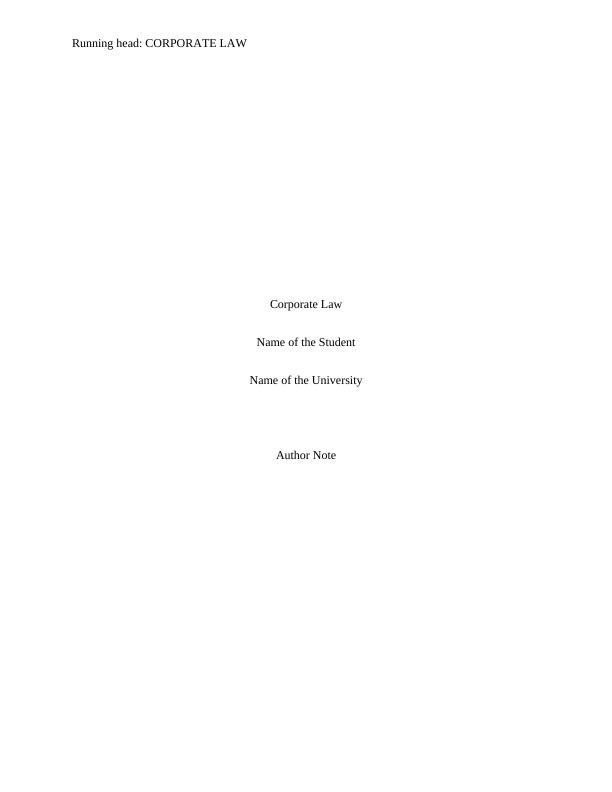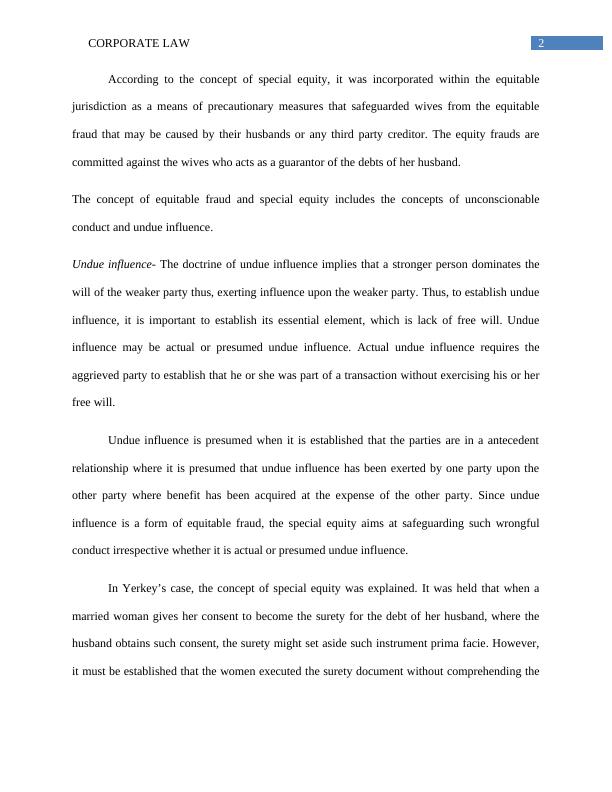Corporate Law Issues and Facts - Assignment
Added on 2021-06-18
7 Pages1756 Words54 Views
Running head: CORPORATE LAWCorporate LawName of the StudentName of the UniversityAuthor Note

1CORPORATE LAWIssues and FactsAs per the facts of the case National Australia Bank v Garcia (1998) 194 CLR 395, Mrs.Garcia, the appellant and her former husband mortgaged their home and executed it in favor ofNational Australia Bank Ltd. The appellant signed a guarantee in favor of the Bank securing thedebts of the company of her former husband. Her husband assured her that there was no riskassociated with the interests she was guaranteeing and neither the bank explained her obligationsas a guarantor. She was a practicing physiotherapist, hence, was assumed intelligent enough tounderstand her role as a guarantor. The parties dissolved their marriage and there was a failure in the business of herhusband as well. The appellant assumed that with the dissolution of marriage her obligations as aguarantor should also dissolve. When the bank demanded guarantees on the failure of thebusiness, the appellant claimed equitable relief against the contract. The trial court ruled that thedocuments were signed by the appellant under undue influence caused by her former husbandwith the assurance that it does not involve any real risks. The Court of Appeal disagreed with thetrial court and overturned the decision given in Yerkley v Jones that is a landmark precedent onequity law in Australia stating the decision does not form a part of the Australian equity law.The High Court rejected the Court of Appeal, upheld the decision in Yerkley, and held that theCourt of Appeal was incorrect to set aside the decision of Yerkley. Relevant Laws and PrinciplesAccording to the Yerkey principle of special equity provides wives with liberalprotection than the doctrine of undue influence. Although recent Australian courts have rejectedto apply, the principle provided in Yerkey v Jones’s case (Hannigan 2015).

2CORPORATE LAWAccording to the concept of special equity, it was incorporated within the equitablejurisdiction as a means of precautionary measures that safeguarded wives from the equitablefraud that may be caused by their husbands or any third party creditor. The equity frauds arecommitted against the wives who acts as a guarantor of the debts of her husband. The concept of equitable fraud and special equity includes the concepts of unconscionableconduct and undue influence. Undue influence- The doctrine of undue influence implies that a stronger person dominates thewill of the weaker party thus, exerting influence upon the weaker party. Thus, to establish undueinfluence, it is important to establish its essential element, which is lack of free will. Undueinfluence may be actual or presumed undue influence. Actual undue influence requires theaggrieved party to establish that he or she was part of a transaction without exercising his or herfree will. Undue influence is presumed when it is established that the parties are in a antecedentrelationship where it is presumed that undue influence has been exerted by one party upon theother party where benefit has been acquired at the expense of the other party. Since undueinfluence is a form of equitable fraud, the special equity aims at safeguarding such wrongfulconduct irrespective whether it is actual or presumed undue influence. In Yerkey’s case, the concept of special equity was explained. It was held that when amarried woman gives her consent to become the surety for the debt of her husband, where thehusband obtains such consent, the surety might set aside such instrument prima facie. However,it must be established that the women executed the surety document without comprehending the

End of preview
Want to access all the pages? Upload your documents or become a member.
Related Documents
The Mortgage and Bankruptcy of a University Student Namelg...
|11
|851
|267
Garcia v National Australia Bank [1998] HCA 48 2017lg...
|6
|1005
|33
Garcia v National Australia Bank: A Landmark Case in Australian Equitylg...
|7
|1530
|428
Case Analysis of Bank of Montreal v. Duguidlg...
|7
|1474
|62
Business and Corporation Lawlg...
|9
|2609
|123
